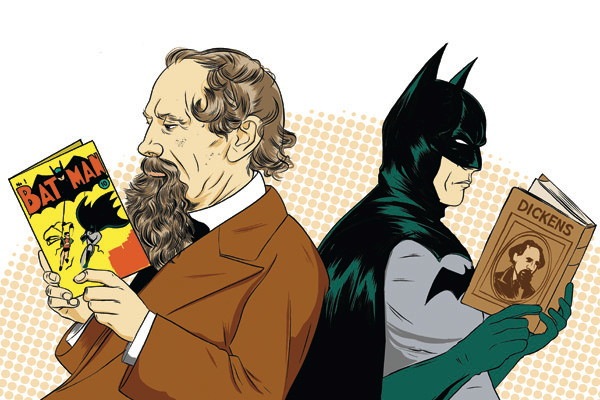§ One of the best spectator sports the last week or so has been the John McAfee story—basically, the guy who invented that anti-virus software that spammed you endlessly in the “cyber” era, is actually a paranoid oddball who has been living in Belize and has fled to the jungle after being accused of killing his neighbor. Whoa, buddy, that software was supposed to stamp out COMPUTER viruses, not NEIGHBORS! Even in the jungle, he managed to launch a blog defending himself. Also in the mix a bit is cartoonist Chad Essley, who, Aaron Colter at Wired tells us, was originally hired two years ago to make a comic for McAfee:
The relationship between the fugitive and the cartoonist began in 2010 on a private internet forum where an anonymous entrepreneur hired Essley to produce an animated web short for an antibiotic venture called Quorumex. The mysterious businessman soon revealed himself as McAfee, and the two struck up a friendship. When the news broke this April that a gang suppression unit had raided McAfee’s property in Belize, Essley was taken aback.
Eventually Essley did go down for a visit, and since then, he’s has begun a comic called THE HINTERLANDS based on his adventures with McAfee. However, he’s also become one of McAfee’s few trusted people and is actually the person who helped McAfee get a website up and running while still on the lam.
“I did it because I had the ability to do so for free, in a keystroke or two,” says Essley. Since then, he has kept McAfee’s often rambling personal blog WhoIsMcAfee.com up and running, and served as one of the only contacts to the millionaire fugitive, who is still on the run.
§ Speaking of Wired, former Comics Alliance e-i-c Laura Hudson is back as entertainment editor for Wired.com. Congrats! Life after blogging. Whoa.
§ J. Caleb Mozzocco looks at Fear Itself, and gives a nice overview of all the major Marvel “Events”, concluding that Fear Itself, by Fraction and Immonen, is one of the most readable, if transient in its effects:
Among the changes (or illusions of change) that occur in the series, the “The Marvel Universe Will Never Be The Same!” and the “long-term repercussions” bits, are the deaths of Bucky Barnes (which leads to Rogers resuming his old costume and codename) and of Thor, neither of which must have stuck very long, as they are both hale and hearty and starring in their own comics as I type this.
§ Best graphic novels of 2012 time at The Observer! Well, really it’s Rachel Cooke’s best of list, and an eclectic one mostly consisting of books published by mainstream publishing houses.
§ Continuing the trend of graphic novels being okay for everyone, it turns out they are now okay in Wales, too!
I’ve always loved comic books. As a young child, one of the highlights of the year was when a new Welsh-language translation of Asterix or Tintin would land in the shops. The thrill of reading Trysor y Rackam Goch for the first time came back to me recently when I read it with my five-year-old son.
§ I did not previously link to Giles Coren’s piece in the Spectator on graphic novels being okay, because it was written in this double negative way that made it sounds like he was heaping the hate on comics. I understand that Coren is a snarky food writer in Britain who specializes in writing shocking things, and this piece resulted in an epidemic of bunched panties around the world. A squad of comics-lovers thundered up on their white chargers in the comment section, and the piece was mostly kicked to bits with pointy knight shoes because it was lame. But a fellow Spectator writer with the unlikely name of Jack van Burholdbind defended the piece for being clever. It was surely clever to stir up all those panties and knights, so there is that. Bottom line? TEH COMICS RULLLEZ DUDE. Also, we get to repost the great illo above which the Spectator neglects to credit. Nice.
§ I did however bookmark THREE TIMES this look at BUILDING STORIES by Gabriel Winslow-Yost for The New York Review of Books because it is really well-written and does a good job of contextualizing BUILDING STORIES in terms of Chris Ware’s previous works. In other words, if you must read ONLY ONE piece about BUILDING STORIES…
Building Stories centers on a run-down Chicago apartment building, whose three floors form a kind of triptych of loneliness. The “old woman” (as she is referred to in passing—none of the four inhabitants is ever named, a much less noticeable decision in a comic than in a prose novel) on the ground floor, who owns the building and has lived in it her entire life, has settled into solitude for good; she doesn’t dream of companionship, but remembers the dreams of it she used to have, with a mix of regret and relief. The “married couple” on the second floor are lonely together, trapped in a cycle of fighting and apologizing so habitual it precludes any real contact between them. And the “girl” on the third floor—the book’s heroine, actually a young woman in her late twenties, a shy art school graduate with a prosthetic leg and a menial job at a flower shop—is lonely with a youthful, frenzied desperation, convinced she’ll be alone forever: “God…I can’t bear it…Am I really so awful? I must be…I must be…”
§ Abhay Khosla provides an infographic on the overuse of the word “masterful” at one particular website. In case you are wondering:







